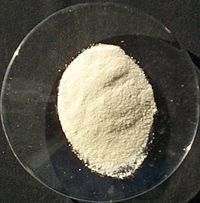
Photo from wikipedia
Copper oxide nanoparticles (Nano-CuO) toxicity has been researched widely in recent years. However, the relationship between oxidative stress and ER-stress and the possible mechanisms induced by Nano-CuO have been rarely… Click to show full abstract
Copper oxide nanoparticles (Nano-CuO) toxicity has been researched widely in recent years. However, the relationship between oxidative stress and ER-stress and the possible mechanisms induced by Nano-CuO have been rarely studied. Here, the mechanism of hepatotoxicity and apoptosis through oxidative stress and ER-stress induced by Nano-CuO was investigated in vivo and in vitro. In in vivo experiments, male Wistar rats were intranasally instilled 10 μg Nano-CuO/g body weight daily for 60 days, which caused liver function impairment, oxidative stress, inflammatory response, histopathological and ultrastructural damage, ER-stress and apoptosis in liver tissue. in vitro experiments on rat hepatocytes BRL-3A cells showed that exposure to Nano-CuO for 24 h resulted in excess production of reactive oxygen species leading to decrease in mitochondria membrane potential causing cell death by inducing apoptosis. However, administration of n-acetyl cysteine decreased the apoptosis in Nano-cuo treated group. The in vivo and in vitro experiments confirmed that oxidative stress triggered ER-stress pathway, leading to the opening of apoptosis pathways of CHOP, JNK, and Caspase-12. In summary, treatment of Nano Cuo triggered oxidative stress by ROS, which in turn resulted in activation of ER stress pathways causing cell death in liver tissue and BRL-3A cells.
Journal Title: Journal of hazardous materials
Year Published: 2020
Link to full text (if available)
Share on Social Media: Sign Up to like & get
recommendations!